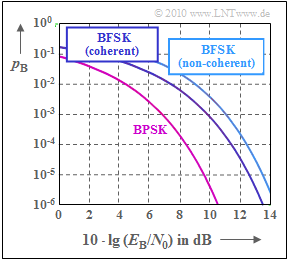Exercise 4.18Z: BER of Coherent and Non-Coherent FSK
The diagram shows the bit error probability for "binary FSK modulation" $\rm (BFSK)$ with
- coherent demodulation, or
- incoherent demodulation
in comparison with binary phase modulation $\rm (BPSK)$. Orthogonality is always assumed.
- For coherent demodulation, the modulation index $h$ can be a multiple of $0.5$, so that the purple curve is also valid for "Minimum Shift Keying" $\rm (MSK)$.
- On the other hand, for non-coherent demodulation of a BFSK, the modulation index $h$ must be a multiple of $1$.
This system comparison is based on the AWGN channel, characterized by the ratio $E_{\rm B}/N_0$. The equations for the bit error probabilities are as follows for
- BFSK with coherent demodulation:
- $$p_{\rm B} = {\rm Q } \left ( \sqrt {{E_{\rm B}}/{N_0} }\right ) \hspace{0.05cm}.$$
- BFSK with non-coherent demodulation:
- $$p_{\rm B} = {1}/{2} \cdot {\rm e}^{- E_{\rm B}/{(2N_0) }}\hspace{0.05cm}.$$
- BPSK, only coherent demodulation possible:
- $$p_{\rm B} = {\rm Q } \left ( \sqrt {{2 \cdot E_{\rm B}}/{N_0} }\right ) \hspace{0.05cm}.$$
Remember:
- For BPSK, the log ratio $10 \cdot {\rm lg} \, (E_{\rm B}/N_0)$ must be at least $9.6 \, \rm dB$ so that the bit error probability does not exceed the value $p_{\rm B} = 10^{\rm -5}$.
- For binary modulation methods, $p_{\rm B}$ can also be replaced by $p_{\rm S}$ and $E_{\rm B}$ by $E_{\rm S}$.
- Then we speak of the symbol error probability $p_{\rm S}$ and the symbol energy $E_{\rm S}$.
Notes:
- The exercise belongs to the chapter "Carrier Frequency Systems with Non-Coherent Demodulation".
- However, reference is also made to the chapter "Carrier Frequency Systems with Coherent Demodulation".
- Further information can be found in the book "Modulation Methods".
- Use the approximation ${\rm lg}(2) \approx 0.3$.
Questions
Solution
- In other words: The coherent BFSK curve lies $10 \cdot {\rm lg} \, (2) \approx 3 \ \rm dB$ to the right of the BPSK curve.
- To guarantee $p_{\rm B} ≤ 10^{\rm –5}$, it must hold:
- $$10 \cdot {\rm lg}\hspace{0.05cm} {E_{\rm B}}/ {N_{\rm 0}}\approx 9.6\,\,{\rm dB} + 3\,\,{\rm dB}\hspace{0.15cm} \underline{=12.6\,\,{\rm dB}}\hspace{0.05cm}.$$
(2) Solution 2 is correct:
- The given equation is valid not only for the MSK $($this is a BFSK with $h = 0.5)$, but for any form of orthogonal BFSK.
- Such a BFSK exists if the modulation index $h$ is an integer multiple of $0.5$, for example for $h = 1$.
- With $h = 0.7$ there is no orthogonal FSK.
- It can be shown that for $h = 0.7$ there is even a smaller error probability than with orthogonal FSK:
- With $10 \cdot {\rm lg} \, E_{\rm B}/N_0 = 12.6 \ \rm dB$ one even achieves $p_{\rm B} \approx 10^{\rm –6}$, here, i.e. an improvement by one power of ten.
(3) From the inverse function of the given equation, one obtains:
- $$\frac{E_{\rm B}} {2 \cdot N_{\rm 0}}= {\rm ln}\hspace{0.05cm}\frac{1}{2 p_{\rm B}}= {\rm ln}(50000)\approx 10.82\hspace{0.3cm} \Rightarrow \hspace{0.3cm} {E_{\rm B}}/ {N_{\rm 0}}= 21.64 \hspace{0.3cm}\Rightarrow \hspace{0.3cm} 10 \cdot {\rm lg}\hspace{0.09cm} {E_{\rm B}}/ {N_{\rm 0}}\hspace{0.15cm} \underline{\approx 13.4\,\,{\rm dB}}\hspace{0.05cm}.$$
(4) From $10 \cdot {\rm lg} \, E_{\rm B}/N_0 = 12.6 \ \rm dB$ follows:
- $${E_{\rm B}} /{N_{\rm 0}}= 10^{1.26} \approx 16.8 \hspace{0.3cm}\Rightarrow \hspace{0.3cm} \frac{E_{\rm B}} {2 \cdot N_{\rm 0}}\approx 8.4 \hspace{0.3cm} \Rightarrow \hspace{0.3cm} p_{\rm B} = {1}/{2} \cdot {\rm e}^{- 8.4}\hspace{0.15cm} \underline{ \approx 0.012 \%= 12 \cdot 10^{\rm -5}}\hspace{0.05cm}.$$
This means: For the same $E_{\rm B}/N_0$, the error probability for non-coherent demodulation is increased by a factor of about $12$ compared to coherent demodulation according to subtask (1).
